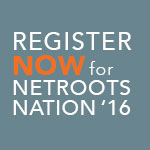After a great run, the Winning the Internet blog has been retired. However, you can still keep in touch with New Media Mentors here.
As we get ready for Netroots Nation 2015, we’re taking a closer look at some of the convention’s most exciting training sessions. We’re interviewing the trainers and taking you inside some of online activism’s most popular and elusive topics.
Today we’re interviewing Travis Moore of Tech Congress, who’ll be leading This is what happens in a Congressional office when you write your rep, along with Yuri Beckelman, Deputy Chief of Staff and Legislative Director for Congressman Mark Takano of California.
NN15 Training Session
This is what happens in a Congressional office when you write your rep
Former and current Congressional staffers give an inside look at how Congressional offices receive, process and respond to emails and constituent mail, plus share advice about effective online advocacy.
Interview
Q: Tell us about yourself and your experience handling constituent emails and mail for Congressional Offices.
A: I worked on Capitol Hill for six years for Rep. Henry Waxman, and helped close down the office at the end of last year. I was his Legislative Director for my last two years on Capitol Hill. In our office all legislative staff wrote their own letters — they responded to the mail that was received related to their issue portfolio. On any given week, I would write between 20 and 40 responses to emails sent to Rep. Waxman, and I’d approve hundreds of email responses written by our Legislative Correspondent and Legislative Assistants. We processed over 106,000 constituent letters last year.
Before I came to the Hill I was on the web and advocacy team at the United Nations Foundation. A good portion of my days were spent in Convio or Salsa writing and mocking up emails to the UNF lists, in many cases asking UN Foundation supporters to write their Member of Congress in support of UN Peacekeeping or malaria funding.
I’ve written the email blasts to Congress from the outside and responded to constituent mail on the inside. It’s hard work for everyone and I think I have a sense of the challenges on both sides.
Q: In your opinion, what is the most common mistake that organizations make when doing online advocacy to Congressional Offices?
A: The most fundamental, serious mistake: not including basic information about constituent signers when delivering a petition.
Organizations are increasingly hand-delivering signed petitions instead of pushing their lists to write their reps directly. Advocates then deliver the petition by emailing the Legislative Director with a link to a file listing its signers (sometimes as a PDF) or by hand-delivering the petitions on paper. In many cases these constituent petition lists don’t include the constituent’s email or physical address. Consequently, offices can’t cross reference and upload those petitions to their constituent database and CRM in order to verify that the signer lives in the Member’s district, record their support or opposition and respond to them about the issue.
When sending a petition to an office advocates should include the same basic information a constituent would provide if they were writing their rep directly.
Q: What are the two most important things to keep in mind when doing this kind of advocacy?
A: First, it’s important to recognize that most offices are in perpetual backlog answering constituent mail. This is a problem in virtually every office– Republican or Democratic, new or old. Offices are receiving between 150 and 500 messages a day. It’s not any one person’s fault, and there are a variety of causes, but staff are quite literally buried in constituent mail. And an organizer accustomed to modern digital platforms and CRMs would balk at the tools available to Congress– offices don’t have basic functionality like A/B testing or easy list segmentation.
Breaking through the noise in Congress, because of the volume of the mail and the mediocrity of the CRMs, is a big challenge. If an issue is time sensitive (a pending vote, or letter being circulated for sign-on), it’s important to take these constraints into account.
Second, don’t assume that 300 identical emails from constituents will be more influential than one meeting with a the right staff, or a personal story delivered directly to the right staffer or the Member. Getting a flood of mail on an issue is important in influencing how a Member will decide to vote on an issue, but personal stories and one-on-one interactions are still especially powerful if well targeted and well delivered.
Q: Why should folks attend your session at Netroots Nation, and how can they connect with you?
A: We’re going to walk through the process of how Congressional offices receive, process and send responses to the constituent mail it receives step by step. We’ll discuss which staff handle mail at which part of the process, how that information is relayed to a Member of Congress, how that information affects a Member’s decision making process, and where the opportunities for influence exist. We’ll share some specific tips for effective online advocacy, as well as a couple case studies of good partnerships between Member offices and advocacy organizations.
In the end, Hill staff and progressive organizers and advocates are trying to accomplish a lot of the same things. I hope folks will join the session and we can demystify a bit of what goes on from the staff perspective in Congress.
People can connect with me throughout the Netroots Nation conference or via Twitter (@travismoore).
To attend this training, or one of the 39 others at Netroots Nation 2015 in Phoenix, register now.




Comments are closed.